 Hartlepool Sports & Leisure
Hartlepool Sports & Leisure
- Cinemas, Theatres & Dance Halls
- Musicians & Bands
- At the Seaside
- Parks & Gardens
- Caravans & Camping
- Sport
 Hartlepool Transport
Hartlepool Transport
- Airfields & Aircraft
- Railways
- Buses & Commercial Vehicles
- Cars & Motorbikes
- The Ferry
- Horse drawn vehicles
 A Potted History Of Hartlepool
A Potted History Of Hartlepool
- Unidentified images
- Sources of information
- Archaeology & Ancient History
- Local Government
- Printed Notices & Papers
- Aerial Photographs
- Events, Visitors & VIPs
 Hartlepool Trade & Industry
Hartlepool Trade & Industry
- Trade Fairs
- Local businesses
- Iron & Steel
- Shops & Shopping
- Fishing industry
- Farming & Rural Landscape
- Pubs, Clubs & Hotels
 Hartlepool Health & Education
Hartlepool Health & Education
- Schools & Colleges
- Hospitals & Workhouses
- Public Health & Utilities
- Ambulance Service
- Police Services
- Fire Services
 Hartlepool People
Hartlepool People
 Hartlepool Places
Hartlepool Places
 Hartlepool at War
Hartlepool at War
 Hartlepool Ships & Shipping
Hartlepool Ships & Shipping

Seaton Snook
Details about Seaton Snook
A former small village within the Borough of Hartlepool.
Location
Related items :
 1940s and 50s Memories of Seaton Snook by the Lee Family
1940s and 50s Memories of Seaton Snook by the Lee Family
Memories of Seaton Snooks from the Lee family
(see photos also)
The Snooks looked very different back in the 1940s. It wasn't until after the war that barbed wire was removed from the beach. The Zinc works road curved to the right with houses on the left hand side of the road and the community centre and school on the right.
There was no way through to the beach. The only way was up and over the dunes. These were much higher than today's dunes, well over 20 feet tall. The children loved sliding down them but also remember carrying food, water, fuel, bags and boxes over the dunes from the road to the boat.
The tide didn't come in as far as it does now. The beach stretched out much further with pools of water just made for playing in.
The way through the dunes wasn't created until the early 50s when Thompson’s firm began removing sand from the beach. At about this time a stand pipe was installed at the curve of the road, approximately where the road now ends. This was luxury as before that fresh water needed to be obtained from the Zinc works. The children would sit on the top of the dunes with their buckets and watch out for their father who would go into the zinc works for them (only men were allowed in).
Boats:
The Lee family had several boats at the Snooks from the 1940s. (The ISOBEL, The FOUR SISTERS and later The MAHOUT).
Mr. Lee and his son converted old wooden lifeboats into houseboats. At that time wooden boats were being replaced by fibre glass and so could be bought for about £10.
The ISOBEL was converted from one of the lifeboats from The British Lady, a hospital ship which was about to be scrapped in Sunderland. The lifeboat cost £10.
Mr. Lee built a shed on the deck (like Noah's Ark); there were wooden steps down into the boat; around the walls were cupboards, a Primus stove oven, beds - some made from wooden slats but others converted from old army stretchers. The girls remember three children sharing a single bed!
The Four Sisters boat was named after the four Lee sisters (Maureen, Philomena, Isobel and Mary).
There were different types of boats. Jack Corkin who lived at Graythorpe converted a wooden torpedo boat. He moored at Greatham Creek in winter and at the Snooks in the Summer.
Getting there:
The Lees lived in Maritime Street near the river in Stockton so on occasion Dad and Joseph rowed and sailed the coble, the Patience to and from the Snooks. Before the family had use of a works van, Dad used to pile up to three children in a motorbike side car attached to his bicycle and pedal all the way from Stockton.
Life at the Snooks:
The Lee family lived on board their boats during the summer holidays and most weekends.
Although the family remember very happy times as children, living on the boats could be hard work, especially for their mother who had five children to feed and keep clean on a small boat. Mrs. Lee kept butter and milk in a biscuit tin which was then buried in the sand to make a simple fridge. The spot was marked with a stick but unfortunately, sometimes at the high spring and autumn tides, the tide came in and swept away the stick so the children had to dig around until they found the food.
The Lee children rowed out to catch fish and empty the lobster pots. They remember how large the lobsters were and how this 'luxury food' seemed common place to them.
The family recall taking a pram to the gas works in Stockton and collecting a bushel of cinders. These cinders were added to the fire and burned white hot. They didn't spit as much as sea coal.
The winkle beds were exposed for a couple of hours at each tide and the family remembers collecting winkles and spearing Plaice or 'flatties' with a sharp stick.
Play time:
There was lots of fun to be had - sliding down dunes and even pole vaulting! Isobel remembers that she and her sister, Philomena, found a neglected house boat that was half hidden in the dunes. They dug their way in, held tea parties and then proceeded to paint the boat silver! She knew that they would be in great trouble if they were ever caught as their father had drummed it into them that they were not allowed on other people's boats without permission.
When residents of Seaton Snooks village moved out, the children from the boats enjoyed playing in and out of the deserted houses. They remember climbing through the chapel windows and playing the organ! There were also war-time 'pill boxes' to play in; some were quite large with an upstairs and downstairs.
Having a bath:
Men and boys could use the showers at the zinc works but the women and girls had to make other arrangements. Mr. Lee dug a trench to use as a bath. This filled with rainwater (and creepy crawlies) to which was added a couple of buckets of fresh hot water from the zinc works.
Celebrating a special birthday:
When Maureen Lee was 21, there was a great celebration on the beach. The family built a large round table out of sand and the meal was served there.
Storms:
The boats usually rested on the sand and only floated at high Spring and Autumn tides. As the river was dredged the tide came in further and more frequently.
The family remember one wild night when the storm was so bad that the next door boat was in danger of crashing into theirs so the men waded chest deep in the icy water while the girls balanced precariously on the deck using brooms and planks, anything they could find, to fend off the other boat.
One night a boat, The NANCY BETT, Albert Lee's boat, broke loose and ended up at Eston. It crashed into the walkway between the lighthouse and living quarters before ending up on the beach where Tees-dock now stands.
Publicity:
The family remembers how things changed once an article about the Snooks appeared in the Gazette. No longer was it a 'hidden gem', now strangers and day trippers came which changed the character of the area. Those who stayed in the boats enjoyed it more when the visitors went home.
The burning of the boats:
By the late 1960s, there were about 25 house boats on the beach. The boat owners were told to remove their boats. Most had nowhere to take them and so burned their own boats. The authorities had told them that it was because the tides were now higher as the river had been dredged - an explanation not accepted by the locals. Mr. Lee could not bear to burn his boats so his son-in-law Joe Wilson undertook this sad task.
More detail »
 1938 hut at Seaton Snooks
1938 hut at Seaton Snooks
 Donated by Frances Wilson
Donated by Frances WilsonDated 1938
Enjoying the sunshine outside a chalet at Seaton Snooks in 1938.
More detail » At the Snooks (1)
At the Snooks (1)
 Donated by Mr. Keith Bloomfield
Donated by Mr. Keith BloomfieldDated 1935
Dorothy Dennis in front of her beach hut at Seaton Carew in the mid-1930s. At this time there were a lot of beach huts at the end of the 'snooks', not far from the present bus station. They were taken away at the beginning of World War II.
More detail » At the Snooks (2)
At the Snooks (2)
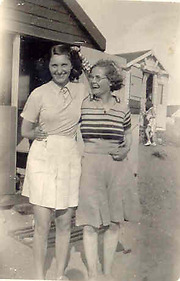 Donated by Mr. Keith Bloomfield
Donated by Mr. Keith BloomfieldDated 1935
Dorothy Dennis and a friend at her beach hut at Seaton Carew in the mid-1930s. At this time there were a lot of beach huts at the end of the 'snooks', not far from the present bus station. They were taken away at the beginning of World War II.
More detail » At the Snooks (3)
At the Snooks (3)
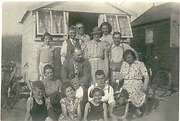 Donated by Mr. Keith Bloomfield
Donated by Mr. Keith BloomfieldDated 1935
Guy Dennis surrounded by friends at the beach hut at Seaton Carew in the mid-1930s. At this time there were a lot of beach huts at the end of the 'snooks', not far from the present bus station. They were taken away at the beginning of World War II. The small boy front row, far left, is Keith Bloomfield.
More detail » At the Snooks (4)
At the Snooks (4)
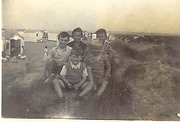 Donated by Mr. Keith Bloomfield
Donated by Mr. Keith BloomfieldDated 1934
On the 'Snooks' near the beach huts, August Bank Holiday 1934. The boy left centre is unknown, but the other four are cousins; at the back Joan Hutchinson and Jackie Smurthwaite, with Keith Bloomfield (centre front), and Ronnie Smurthwaite (front right).
More detail » At the Snooks (5)
At the Snooks (5)
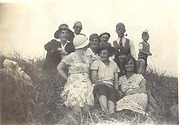 Donated by Mr. Keith Bloomfield
Donated by Mr. Keith BloomfieldDated 1934
A family group at the 'Snooks', on the August Bank Holiday, 1934. Back row from left: Guy Dennis (in large ladies hat), Harry Hutchinson (cap), Maud Bloomfield (cap), Arthur Bloomfield (hat), and Harold Rayner (cap). In front from left: Celia Devlin (facing away - later married Harold Rayner), Ada Hutchinson (in hat), Olive Foster (partly hidden), and Isabel Smurthwaite. Keith Bloomfield is in shorts at the back on the right.
More detail »
 At the Snooks (6)
At the Snooks (6)
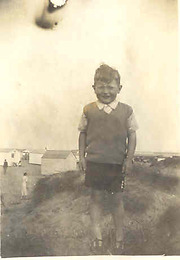 Donated by Mr. Keith Bloomfield
Donated by Mr. Keith BloomfieldA young Keith Bloomfield in the sand dunes at the 'snooks' in the mid-1930s, with the beach huts in the background.
More detail » Chapel Entry
Chapel Entry
 Created by Mrs Clark
Donated by Bowes Museum, Barnard Castle, County Durham
Created by Mrs Clark
Donated by Bowes Museum, Barnard Castle, County DurhamPart of the Part of the Pattison's Photographs collection
Seaton Snook Chapel Entry a sketch from Margaret Lawson's book which was in James Pattison's collection. The sketch is signed Mrs Clark. The spot between the sand dunes marked on the Admiralty Charts as Chapel Entry is thought to be where the original Seaton chapel, dedicated to Thomas a'Beckett stood. Stones thought to be from the chapel were used for the foundations in the building of Mr Pearse's barn on the Snook.
More detail » Cobles at the Snooks
Cobles at the Snooks
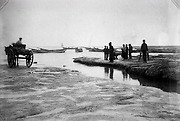 Created by James Whitehead Pattison
Donated by Bowes Museum, Barnard Castle, County Durham
Created by James Whitehead Pattison
Donated by Bowes Museum, Barnard Castle, County DurhamPart of the Part of the Pattison's Photographs collection
Dated 1888
Back from a fishing trip a man carries his fishing catch towards home. Others chat to a carter.
More detail » Fifth Buoy Light
Fifth Buoy Light
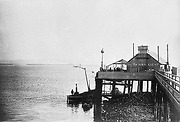 Created by James Whitehead Pattison
Donated by Bowes Museum, Barnard Castle, County Durham
Created by James Whitehead Pattison
Donated by Bowes Museum, Barnard Castle, County DurhamPart of the Part of the Pattison's Photographs collection
Dated 1888
The Fifth Buoy Light at Seaton Snook near the mouth of the Tees in 1888.
More detail » Lee Family Seaton Snook 1950s
Lee Family Seaton Snook 1950s
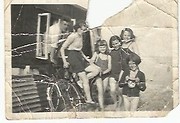 Created by Lee Family
Donated by Lee Family
Created by Lee Family
Donated by Lee FamilyMr Johnson, Philomena Lee on bike, Christine Johnson, Isobel Lee, Maureen Johnson and Mary Lee
More detail » Sand barges at the Snook
Sand barges at the Snook
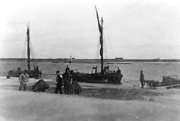 Created by James Whitehead Pattison
Donated by Bowes Museum, Barnard Castle, County Durham
Created by James Whitehead Pattison
Donated by Bowes Museum, Barnard Castle, County DurhamPart of the Pattison's Photographs collection
Dated 1888
Pattison's caption for this image was 'Sand barges at the Snook'. The men are collecting sea coal in wheelbarrows.
More detail »




